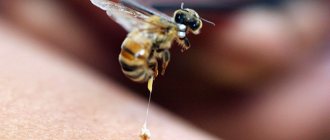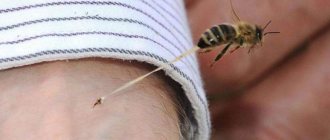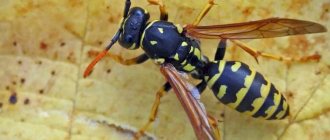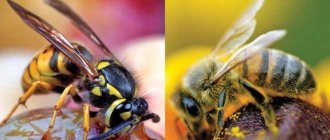What happens when you get stung by a bee, what determines whether you have an allergic reaction, and what to do to prevent it from developing into anaphylactic shock.
Death from a bee sting is quite rare (in Australia, for example, as many people die from their stings as from snake bites), but in terms of the number of hospitalizations caused by stings, bees surpass all other poisonous creatures (see table). According to statistics, allergies to bee venom occur in 0.5–2% of people.
How bees sting
Honey bees are social insects that live in hives. These include worker bees, drones and the queen bee. Some worker bees take care of the queen, who produces bee offspring, and some collect nectar and pollen from the fields and bring them to the hive.
On the abdomen of the bee there is a so-called stinging apparatus: two poisonous glands, a reservoir for poison and a sting with serrations. This is a defense mechanism that bees use if they or the hive are attacked. Thanks to the serrations, the sting pierces the skin of an animal or person. The bee injects poison and at the same time begins to emit pheromones, “calling” other individuals to join the defense.
Bee venom consists of proteins and organic molecules that, when entering the victim's body, cause pain, swelling, itching and redness. These symptoms may persist for several days.
A single bee sting rarely causes a severe allergy, but some people are hypersensitive to certain proteins in bee venom, so that even one sting can lead to a life-threatening anaphylactic reaction.
This is why we talk about allergies and not bee venom poisoning; It is an allergy to bee venom that puts thousands of people in hospital beds every year.
However, poisoning is also possible: the lethal dose of bee venom for humans is about 0.2 g (500–1000 stings).
First aid for a bee sting
First aid for a bee sting should include the following steps:
- removal of the sting;
- treating the resulting wound with antiseptic drugs;
- removing bee venom from the body.
If you know exactly how to properly assist with a bee sting, you can avoid many unpleasant (and in some cases even life-threatening) consequences.
Unlike a wasp, which stings a person without losing its sting, a bee always leaves it at the site of the bite. This occurs due to the special shape of the bee sting and the presence of sawtooth serrations on it. Trying to remove the sting from the skin of the victim, the bee makes a jerk, due to which it is disconnected from the body of the insect. This leads to damage to internal organs: it is because of them that the bee always dies after being stung.
With the help of a sting, a bee injects poison into the body of a person or animal, leading to burning pain and swelling. Typically, the amount of poison entering the body in one bite is up to 0.3 mg - this is quite enough so that the bee’s potential enemy no longer threatens it and the entire colony. If the amount of toxins reaches 0.2 g (which can happen in the case of large numbers of bee stings), this can pose a threat to life.
Bee venom enters the victim’s body not only during the bite, but also after it. This is explained by the fact that the sting has a supply of special toxins that enter the blood of the bitten person or animal even after the death of the bee. Therefore, the first thing to do after a bee sting is to remove the sting.
Tweezers, tweezers or a needle are used to remove the bee sting. If you don’t have them at hand, simply press firmly on the bite site on both sides with clean fingers: this will not only help remove the sting, but will also make it possible to squeeze out a little bee venom from the wound.
After removing the bee sting, you need to treat the bite site as soon as possible. For this, any alcohol-containing solution is useful: iodine, calendula tincture, ammonia, hydrogen peroxide. You can also prepare a slightly pink solution of potassium permanganate or treat the wound with vodka. If you don't have any alcohol-based product, just wash it with cold water and soap. You can also prepare a soda or saline solution: per glass of water you will need a teaspoon of baking soda or table salt.
To reduce the risk of swelling after a bee sting, it is recommended to apply an ice cube to the stung area. This will not only help prevent the development of swelling, but will also dull the pain.
If the bee sting did not occur at home, and you do not have the opportunity to treat the wound with antiseptics, pick a leaf of plantain, parsley or yarrow. It needs to be rinsed from dust and rubbed into a paste with your fingers so that a little juice comes out. It is recommended to lubricate the stung area with this juice.
After removing the bee sting and treating the wound with an antiseptic, you need to remove toxins that have already been absorbed into the blood from the body as soon as possible. To do this, you need to drink as much cool liquid as possible. You can also use activated carbon or any other enterosorbent.
It is recommended to prepare an infusion of string: this herb is not only an excellent means of removing bee toxins from the body, but also has an antipruritic effect. To prepare the infusion, take 3 tablespoons of dry herb and pour two cups of boiling water, leave for at least 8 hours and take half a glass before meals three times a day.
How to find out if you are allergic to bee venom
If you have never been stung by a bee before, you most likely do not have an allergy to bee venom. But if it is stung, then the risk of developing an allergic reaction is quite high. The cause of an allergy to bee venom is still unclear, but there is every reason to believe that the more often a person is stung, the higher the risk of allergic reactions.
If the bee sting area is very swollen or the symptoms affect the entire body, then you are allergic to bee venom .
If swelling and itching at the sting site lasts more than a day, and the diameter of the swelling exceeds 10 cm, this is a local allergic reaction. Symptoms from the skin, lungs, and gastrointestinal tract are a systemic reaction. Mild systemic reactions include skin itching, urticaria, and malaise. If symptoms from the gastrointestinal tract (abdominal pain, nausea, vomiting, loose stools) or vascular edema are added, this is a reaction of moderate severity. Choking due to bronchospasm or swelling of the upper airways is considered a severe reaction. A sharp decrease in blood pressure and loss of consciousness is anaphylactic shock, which can be fatal.
To determine how high the risk of systemic reactions, and especially anaphylactic shock, is for you, you need to see a doctor and undergo an allergological examination.
Symptoms
When a bee stings, the body reacts as follows: severe redness, pain, swelling, swelling occurs at the site of the bite, and the temperature in the affected area rises. As a result of exposure to the poison, dizziness, weakness, nausea, shortness of breath and headaches develop. Symptoms are pronounced within several hours. The use of folk remedies, medications and injections helps relieve unpleasant symptoms after a bee sting. Within a day the condition improves.
If a person is allergic to bees, the effect of the poison can cause a state of shock, accompanied by difficulty breathing, and the appearance of allergic spots on the body. Swelling of the neck, forearm, face, and limbs occurs. Blood pressure may decrease and body temperature may rise. The following symptoms are also observed:
- convulsions;
- rash, redness, pain;
- nausea, vomiting;
- difficulty breathing;
- increased weakness;
- loss of consciousness;
- disturbances in the digestive tract.
In the absence of timely medical attention, an allergy to a bee sting can be fatal.
Bee stings are dangerous for pregnant women and children. In this case, treatment is complicated by the fact that many medications are contraindicated.
What is first aid for a bee sting?
When a bee stings, the jagged stinger gets stuck in the skin and remains there. Remove it immediately (preferably in the first 30 seconds) - this way less poison will enter the body. You can squeeze out the sting with your fingernails, but it’s better to use a bank card or car keys.
If the reaction at the site of the bite is minor, that is, there is pain, redness or slight swelling, apply something cold, preferably a cold compress with ice. This will make the symptoms go away faster.
If a bee stings you in the neck or head and you have difficulty breathing or feel dizzy, call an ambulance immediately.
Or give yourself an adrenaline injection. The dose for adults is 0.3 ml of 0.1 percent adrenaline, for children – 0.1 ml.
Allergic reaction to bites
Each person has their own unique reaction to a bee sting. Depending on the degree of complexity, they can be divided into several groups:
- Strong;
- Moderate;
- Weak.
Allergic reaction to bites
Video: Bee sting - how to relieve swelling
Each degree of bite allergy has its own symptoms. With a mild allergy, redness and an unpleasant burning sensation in the bite area are observed. The average degree is characterized by:
- Nausea;
- Slight swelling;
- Dizziness;
- Weakness.
The strongest form is considered the most severe. With it the following are observed:
- Large swelling at the site of the bite;
- Vomit;
- Bleeding;
- Lack of oxygen.
Important! Different reactions are observed not only in different people, but also at different times in the same person. Mild symptoms may be observed once, but the next time the bite occurs the reaction will be much more serious.
What precautions to take
Bees are not pests, but very beneficial insects: they pollinate plants and make honey, and many medicines are made from bee venom. Some active components of bee venom are used to treat cancer. Therefore, we will not fight them, but will try to avoid bites .
If you see a bee, do not try to swat it or crush it with your foot: bees only attack if they feel the hive is threatened.
If you have an improvised hive in your summer cottage, do not try to find it yourself, much less destroy it - invite a specialist.
How to treat allergies to bee venom
Severe allergic reactions to bee venom can be avoided by taking a course of allergen-specific immunotherapy (ASIT). This is the only method of treating allergies, and it is very effective. The same method is used in the treatment of hay fever.
How does he work? You have been injected with bee venom allergen for a long time. They start with small doses, then gradually increase them, bringing them to the optimum, and then this final maintenance dose is injected from 3 to 5 years. You can consult about ASIT if you are allergic to Hymenoptera venom at the State Scientific Center Institute of Immunology of the Federal Medical and Biological Agency of Russia.
Sources: allergotop.com, medicalxpress.com
Treatment
Many people suffer from allergies caused by the venom of a bee sting. They experience hives, severe swelling, and anaphylactic shock. A single bite can cause the most unpredictable consequences. To relieve swelling, you need to disinfect the wound, then apply a cold lotion using hydrogen peroxide or ammonia. Treatment includes the use of antihistamines: tablets, injections, ointment.
To treat a bee venom allergy, it is important to know some facts. Useful articles on the topic - why bee venom is a medicine.
There are three stages of allergy manifestation:
- increased body temperature, development of urticaria and Quincke's edema, chills;
- the rhythm of the heart muscle is disrupted, intestinal spasm appears, these symptoms are accompanied by swelling of the mucous membrane;
- the third stage is considered the most dangerous because it is accompanied by anaphylactic shock and death.
People who have an allergic reaction to bee venom should carry a syringe filled with adrenaline to avoid anaphylactic shock. This manipulation will help in case of a single bite. Multiple bites require emergency medical attention.
Allergy to bees can be treated with Suprastin, which is considered an effective antihistamine. Dosage: adults - 1 tablet three times a day, children (6-14 years old) - ½ tablet twice a day.
First aid
If a person has been bitten by a bee, certain actions must be taken:
- To begin with, the sting is removed from the wound so that it does not penetrate deeper. All manipulations are carried out using tweezers, which are treated with an alcohol solution. If this equipment is not available, remove the bag containing the poison using a disinfected needle.
- The affected area must be treated with a soap solution. Ethyl alcohol or manganese is added to the liquid. You can use ammonia, previously diluted with water.
- To avoid the development of swelling and relieve swelling, use ice, cold water, and dandelion juice.
In case of multiple bites, it is advisable to provide the victim with plenty of warm fluids. If possible, you need to take an antihistamine - Suprastin or Tavegil. Hydrocortisone ointment, Fenistil gel and other preparations are suitable for topical use. A doctor may prescribe Loratadine for a bee sting. It is forbidden to scratch the bite site, even if the itching is unbearable. Forget about drinking alcoholic beverages, otherwise the poison will spread through the blood very quickly.
Folk remedies
To combat swelling and pain from a bee sting, you can use popular folk remedies:
- garlic juice;
- mint juice;
- onion pulp or juice;
- a mixture of water and soda;
- a product based on aspirin, activated carbon and water;
- plantain leaf, dandelion leaf.











